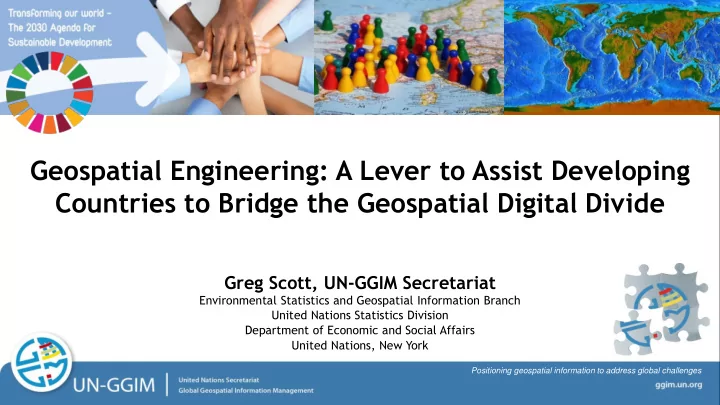

Geospatial Engineering: A Lever to Assist Developing Countries to Bridge the Geospatial Digital Divide Greg Scott, UN-GGIM Secretariat Environmental Statistics and Geospatial Information Branch United Nations Statistics Division Department of Economic and Social Affairs United Nations, New York Positioning geospatial information to address global challenges
To achieve the 2030 Agenda, and bridge the geospatial divide, countries need to enable the development of a national geospatial data ecosystem, robust national information system and associated geospatial frameworks. Positioning geospatial information to address global challenges
“Within the past generation, hundreds of millions of people have emerged from extreme poverty, and access to education has greatly increased for both boys and girls. Further, the spread of information and communications technology and global inter-connectedness has great potential to accelerate human progress, to bridge the digital divide, to develop knowledge societies, and scientific and technological innovation” 2030 Agenda for Sustainable Development, para. 14-15 Providing and exploiting the new data needs, information systems, analytics and associated enabling technologies and tools to support the implementation of the SDGs is going to take strategic policy leadership and transformational change – a digital transformation that is able to bridge the ‘geospatial digital divide’ which continues to inhibit development progress for developing countries. Greg Scott, November 2016
Bridging the Geospatial Digital Divide Positioning geospatial information to address global challenges
The Overarching The Integrated Strategic Framework Geospatial is a mechanism for Information articulating and Framework provides demonstrating a basis and guide for national leadership, developing, cultivating integrating and champions, and strengthening developing the geospatial capacity to take information positive steps. management. http://ggim.un.org/UN-GGIM-Intergrated-geospatial-information-framework/ Positioning geospatial information to address global challenges
I NTEGRATED G EOSPATIAL I NFORMATION F RAMEWORK The Integrated Geospatial Information Framework is a reference guide for developing and strengthening arrangements in national geospatial information management. It has been designed specifically for low to middle income countries and small island developing States. But, it is also being used to improve and coordinate activities to achieve alignment between and across existing national agency capabilities and NSDIs in developed countries. Positioning geospatial information to address global challenges
Recommend
More recommend